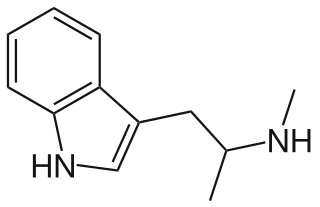
Ergine, also known as d-lysergic acid amide (LSA) and d-lysergamide, is an ergoline alkaloid that occurs in various species of vines of the Convolvulaceae and some species of fungi. The psychedelic properties in the seeds of ololiuhqui, Hawaiian baby woodrose and morning glories have been linked to ergine and/or isoergine, its epimer, as it is a alkaloid present in the seeds.

5-MeO-aMT or 5-methoxy-α-methyltryptamine, α,O-Dimethylserotonin (Alpha-O) is a potent psychedelic tryptamine. It is soluble in ethanol.

4-Hydroxy-N,N-diisopropyltryptamine is a synthetic psychedelic drug. It is a higher homologue of psilocin, 4-HO-DET, and is a positional isomer of 4-HO-DPT and has a tryptamine molecular sub-structure.

Laura Ann Shulgin was an American author and the wife of chemist Alexander Shulgin, with whom she wrote PiHKAL and TiHKAL.

ALD-52, also known as 1-acetyl-LSD, is a chemical analogue of lysergic acid diethylamide (LSD). It was originally discovered by Albert Hofmann in 1957 but was not widely studied until the rise in popularity of psychedelics in the 1960s.

4-HO-MiPT is a synthetic substituted aromatic compound and a lesser-known psychedelic tryptamine. It is thought to be a serotonergic psychedelic, similar to magic mushrooms, LSD and mescaline. Its molecular structure and pharmacological effects somewhat resemble those of the tryptamine psilocin, which is the primary psychoactive chemical in magic mushrooms.

2,5-Dimethoxy-4-chloroamphetamine (DOC) is a psychedelic drug of the phenethylamine and amphetamine chemical classes. It was presumably first synthesized by Alexander Shulgin, and was described in his book PiHKAL.

AL-LAD, also known as 6-allyl-6-nor-LSD, is a psychedelic drug and an analog of lysergic acid diethylamide (LSD). It is described by Alexander Shulgin in the book TiHKAL. It is synthesized starting from nor-LSD as a precursor, using allyl bromide as a reactant.

ETH-LAD, 6-ethyl-6-nor-lysergic acid diethylamide is an analogue of LSD. Its human psychopharmacology was first described by Alexander Shulgin in the book TiHKAL. ETH-LAD is a psychedelic drug similar to LSD, and is slightly more potent than LSD itself, with an active dose reported at between 20 and 150 micrograms. ETH-LAD has subtly different effects to LSD, described as less demanding.

PRO-LAD is an analogue of LSD. It is described by Alexander Shulgin in the book TiHKAL. PRO-LAD is a psychedelic drug similar to LSD, and is around as potent as LSD itself with an active dose reported at between 100 and 200 micrograms.

BU-LAD, also known as 6-butyl-6-nor-lysergic acid diethylamide, is an analogue of LSD first made by Alexander Shulgin and reported in the book TiHKAL. BU-LAD is a psychedelic drug similar to LSD, but is significantly less potent than LSD, with a dose of 500 micrograms producing only mild effects.

N-Morpholinyllysergamide (LSM-775) is a derivative of ergine. It is less potent than LSD but is reported to have some LSD-like effects at doses ranging from 75 to 700 micrograms and a shorter duration. There are fewer signs of cardiovascular stimulation and peripheral toxicity with LSM-775 compared to LSD.

N,N-Dimethyllysergamide or N,N-dimethyl-D-lysergamide (DAM-57) is a derivative of ergine. There has been a single report of observing N,N-dimethyl-D-lysergamide in the illicit drug market. This compound did induce autonomic disturbances at oral levels of some ten times the dosage required for LSD, presumably in the high hundreds of micrograms. There is some disagreement as to whether there were psychic changes observed.

N,N-Diallyllysergamide is a psychedelic lysergamide. In their book TiHKAL, Alexander and Ann Shulgin describe it as being "an order of magnitude less potent than LSD itself".

2,5-Dimethoxy-3,4-methylenedioxyamphetamine (DMMDA) is a psychedelic drug of the phenethylamine and amphetamine chemical classes. It was first synthesized by Alexander Shulgin and was described in his book PiHKAL. Shulgin listed the dosage as 30–75 mg and the duration as 6–8 hours. He reported DMMDA as producing LSD-like images, mydriasis, ataxia, and time dilation.

4,5-MDO-DiPT, or 4,5-methylenedioxy-N,N-diisopropyltryptamine, is a lesser-known psychedelic drug. It is the 4,5-methylenedioxy analog of DiPT. 4,5-MDO-DiPT was first synthesized by Alexander Shulgin. In his book TiHKAL, 4,5-MDO-DiPT produces slight LSD-like effects after several hours. Very little data exists about the pharmacological properties, metabolism, and toxicity of 4,5-MDO-DiPT.

Alpha,N-DMT, or α,N-dimethyltryptamine, is a lesser-known psychedelic drug. It is the α,N-dimethyl analog of DMT. α,N-DMT was first synthesized by Alexander Shulgin. In his book TiHKAL, Shulgin lists the dosage as 50-100 mg, and the duration as 6–8 hours. α,N-DMT causes an unpleasant body load. Very little data exists about the pharmacological properties, metabolism, and toxicity of α,N-DMT.

Alpha,N,O-TMS, or α,N-dimethyl-5-methoxytryptamine, is a lesser-known psychedelic drug. Its abbreviated nomenclature is derived from its structure, as it is α,N,O-trimethyl serotonin. α,N,O-TMS was first synthesized by Alexander Shulgin. In his book TiHKAL, Shulgin lists the dosage as 10-20 mg when taken orally, and the duration as 6–8 hours.

1P-ETH-LAD is an analog of LSD. 1P-ETH-LAD is a psychedelic drug similar to LSD. Research has shown formation of ETH-LAD from 1P-ETH-LAD incubated in human serum, suggesting that it functions as a prodrug. It is part of the lysergamide chemical class. Like ETH-LAD, this drug has been reported to be significantly more potent than LSD itself, and is reported to largely mimic ETH-LAD's psychedelic effects.

1B-LSD is an acylated derivative of lysergic acid diethylamide (LSD), which has been sold as a designer drug. In tests on mice it was found to be an active psychedelic, though with only around 1/7 the potency of LSD itself.




















